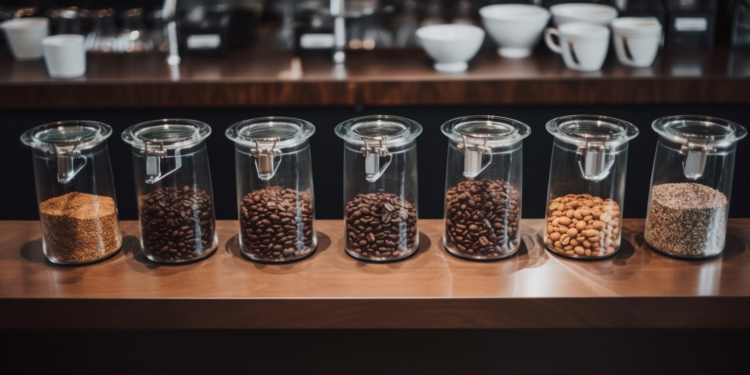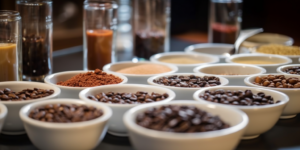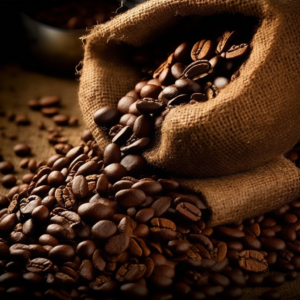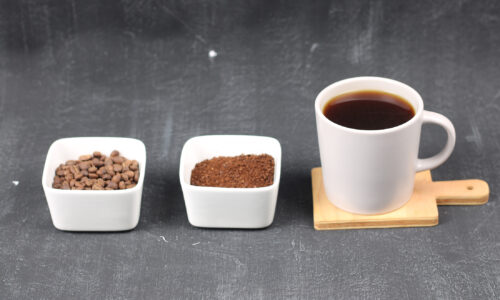Discover the diverse taste and aroma profiles of coffee from different countries around the world in this blog. Learn about the history and culture of coffee in each country, and get tips for brewing and serving each coffee.
Explanation of Cofee Taste and Aroma Profiles
Coffee has a wide range of taste and aroma profiles depending on where it is grown. The soil, altitude, climate, and processing method all contribute to the unique characteristics of each coffee. Understanding these profiles can help you appreciate and enjoy coffee on a deeper level.
Why Different Coffees Taste Different
Different countries have different coffee growing conditions, leading to different flavors and aromas in the beans. For example, coffees grown in Ethiopia have floral and fruity notes, while coffees from Brazil have a nutty and chocolatey taste. By exploring the tastes and aromas of coffee from different countries, you can expand your palate and find new flavors to enjoy.
This blog will take you on a journey around the world to explore the taste and aroma profiles of coffees grown in different countries. We’ll start in Africa, then move to Central and South America, and finish up in Asia and Oceania.
Coffees from Africa
Ethiopia Coffee
Ethiopia is the birthplace of coffee, and the country has a long and rich history with the crop. Ethiopian coffees are known for their floral and fruity flavors, with notes of jasmine, bergamot, and blueberry. Ethiopian coffee is typically grown at high altitudes, which contributes to its bright acidity and complex flavors. Some popular Ethiopian coffee varieties include Yirgacheffe and Sidamo.
To brew Ethiopian coffee, it’s recommended to use a pour-over method or French press to highlight its unique flavors. A medium roast is ideal to preserve the coffee’s bright acidity and delicate flavors.
Kenya Coffee
Kenyan coffee is known for its bright acidity and bold flavors, with notes of black currant, grapefruit, and tomato. The country’s high altitude, rich soil, and cool climate contribute to the unique taste profile of its coffee. Kenyan coffee is typically grown in smallholder farms and processed using the washed method.
To brew Kenyan coffee, a pour-over method is recommended, with a medium to light roast to bring out its bright flavors.
Tanzania Coffee
Tanzanian coffee is characterized by its smooth and mild flavors, with notes of chocolate, nutty, and citrus. The country’s coffee is grown on the slopes of Mount Kilimanjaro and Mount Meru, at elevations between 1,200 and 2,000 meters. The washed method is commonly used to process Tanzanian coffee.
To brew Tanzanian coffee, a French press or drip method is recommended, with a medium roast to bring out its smooth and mild flavors.
Rwanda Coffee
Rwandan coffee is known for its floral and tea-like flavors, with notes of bergamot, peach, and apricot. The country’s coffee is typically grown by smallholder farmers and processed using the washed method. Rwandan coffee is grown at high altitudes, which contributes to its bright acidity and complex flavors.
To brew Rwandan coffee, a pour-over method or French press is recommended, with a medium to light roast to highlight its floral and delicate flavors.
Uganda Coffee
Ugandan coffee is characterized by its full-bodied and earthy flavors, with notes of dark chocolate and spice. The country’s coffee is grown on the slopes of Mount Elgon, at elevations between 1,400 and 2,300 meters. Ugandan coffee is typically processed using the washed or natural method.
To brew Ugandan coffee, a French press or drip method is recommended, with a medium to dark roast to bring out its full-bodied and earthy flavors.
Coffees from Central and South America
Brazil Coffee
Brazil is the largest coffee producer in the world, known for its nutty and chocolatey flavors, with notes of caramel and molasses. The country’s coffee is typically grown at low altitudes and processed using the dry or natural method.
To brew Brazilian coffee, a French press or drip method is recommended, with a medium to dark roast to bring out its nutty and chocolatey flavors.
Colombia Coffee
Colombian coffee is known for its balance of acidity and sweetness, with notes of caramel, chocolate, and fruit. The country’s coffee is grown in the Andes mountains, at elevations between 1,200 and 2,000 meters. Colombian coffee is typically processed using the washed method.
To brew Colombian coffee, a drip or pour-over method is recommended, with a medium roast to bring out its balance of acidity and sweetness.
Costa Rica Coffee
Costa Rican coffee is characterized by its bright acidity and sweet flavors, with notes of citrus, honey, and chocolate. The country’s coffee is typically grown in the Central Valley region, at elevations between 1,200 and 1,800 meters. Costa Rican coffee is typically processed using the washed method.
To brew Costa Rican coffee, a pour -over or drip method is recommended, with a medium roast to bring out its bright acidity and sweet flavors.
Guatemala Coffee
Guatemalan coffee is known for its complex and diverse flavors, with notes of chocolate, caramel, and fruit. The country’s coffee is typically grown in the highlands, at elevations between 1,200 and 1,800 meters. Guatemalan coffee is typically processed using the washed method.
To brew Guatemalan coffee, a drip or pour-over method is recommended, with a medium roast to bring out its complex flavors.
Honduras Coffee
Honduran coffee is characterized by its sweet and fruity flavors, with notes of cherry, apple, and caramel. The country’s coffee is typically grown in the mountainous regions, at elevations between 1,000 and 1,700 meters. Honduran coffee is typically processed using the washed or honey method.
To brew Honduran coffee, a pour-over or drip method is recommended, with a medium roast to bring out its sweet and fruity flavors.
Nicaragua Coffee
Nicaraguan coffee is known for its balanced and smooth flavors, with notes of chocolate, nutty, and citrus. The country’s coffee is typically grown in the northern highlands, at elevations between 800 and 1,500 meters. Nicaraguan coffee is typically processed using the washed or honey method.
To brew Nicaraguan coffee, a drip or pour-over method is recommended, with a medium roast to bring out its balanced and smooth flavors.
Peru Coffee
Peruvian coffee is characterized by its mild and nutty flavors, with notes of chocolate and fruit. The country’s coffee is typically grown in the Andean mountains, at elevations between 900 and 2,100 meters. Peruvian coffee is typically processed using the washed or honey method.
To brew Peruvian coffee, a drip or pour-over method is recommended, with a medium roast to bring out its mild and nutty flavors.
Coffees from Asia and Oceania
Indonesia Coffee
Indonesian coffee is known for its bold and earthy flavors, with notes of spice, tobacco, and chocolate. The country’s coffee is typically grown on the islands of Sumatra and Java, at elevations between 600 and 1,500 meters. Indonesian coffee is typically processed using the wet-hulled method.
To brew Indonesian coffee, a French press or drip method is recommended, with a medium to dark roast to bring out its bold and earthy flavors.
Vietnam coffee
Vietnamese coffee is characterized by its strong and robust flavors, with notes of chocolate and nutty. The country’s coffee is typically grown in the central highlands, at elevations between 800 and 1,200 meters. Vietnamese coffee is typically processed using the wet or dry method.
To brew Vietnamese coffee, a drip or pour-over method is recommended, with a dark roast to bring out its strong and robust flavors.
India Coffee
Indian coffee is known for its spicy and aromatic flavors, with notes of clove, cinnamon, and nutmeg. The country’s coffee is typically grown in the southern region, at elevations between 800 and 1,500 meters. Indian coffee is typically processed using the washed method.
To brew Indian coffee, a drip or pour-over method is recommended, with a medium roast to bring out its spicy and aromatic flavors.
Papua New Guinea Coffee
Papua New Guinea coffee is characterized by its smooth and fruity flavors, with notes of citrus and berry. The country’s coffee is typically grown in the highlands, at elevations between 1,500 and 1,800 meters. Papua New Guinea coffee is typically processed using the washed or natural method.
To brew Papua New Guinea coffee, a pour-over method or French press is recommended, with a medium roast to bring out its smooth and fruity flavors.
Recap of Different Coffee Tastes and Aromas
In this blog, we’ve explored the taste and aroma profiles of coffees from different countries around the world. From the floral and fruity flavors of Ethiopian coffee to the bold and earthy flavors of Indonesian coffee, each country has its own unique characteristics that contribute to the taste and aroma of their coffee.
Suggested Coffees to Try
If you’re looking to try some of the coffees mentioned in this blog, here are some suggestions:
- Ethiopian Yirgacheffe
- Kenyan AA
- Costa Rican Tarrazu
- Guatemalan Antigua
- Indonesian Sumatra
Final Thoughts on Traveling with Coffee
Exploring the taste and aroma profiles of coffee from different countries can be a fun and educational experience. It’s a great way to expand your palate and discover new flavors. Whether you’re traveling to a coffee-producing country or simply trying out different roasts at home, there’s always something new to discover in the world of coffee.
Expanding your coffee knowledge and trying new coffees can also be a way to support smallholder farmers and sustainable coffee practices. Many coffee-producing countries rely heavily on coffee exports as a source of income, and by choosing to buy coffee directly from these countries or from companies that support sustainable and ethical practices, you can help to support these communities and protect the environment.





